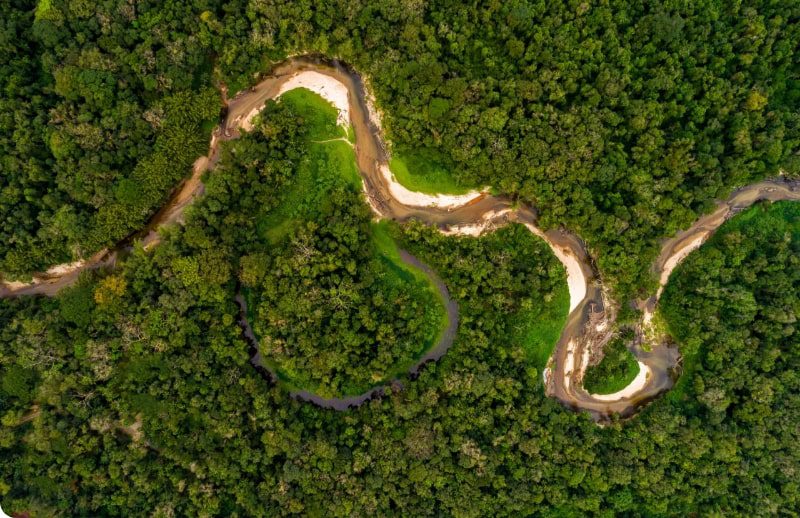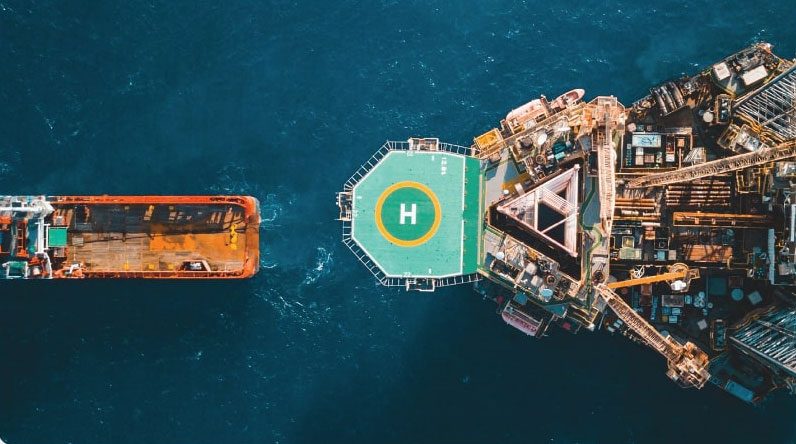Installation Contractor Package
Cathodic Protection Design (DNV-RP-B401 1983)
The Cathodic Protection Design (ANOD) module is used to design a bracelet anode system by helping the engineer to select an appropriate anode size and spacing along the pipeline. Alternatively, the module may be used to quickly check the validity of an existing or proposed design.
The ANOD module calculation method, default values and help screen information, are based primarily on Det Norske Veritas’ recommended practice for cathodic protection design (DNV RP B401, 1993).
Submarine pipelines are protected from external corrosion by a combination of coatings and cathodic protection (CP). The CP system generally consists of sacrificial anode bracelets attached to the pipeline at regular intervals.
The help menus also give additional advice to the engineer on the recommendations from other codes/standards, technical literature, and Penspen in-house data.
For a given set of design criteria, there are generally many feasible designs which satisfy the code requirements. The ANOD module provides graphical outputs to help the engineer to see quickly the benefits of one design over another, and hence to optimise the design by choosing a solution which minimises the total mass of anode material. A further design optimisation feature is the option to calculate an effective utilisation factor, which in certain cases can result in significant savings by increasing the required spacing or reducing the required anode dimensions.
On-Bottom Stability (DNV-RP-F109 2010)
The lateral stability criteria for a pipeline lying on the seabed or in a trench under hydrodynamic forces have to be satisfied. This is achieved by calculating the steel wall thickness or concrete weight coating required to keep the pipe lateral movement below a code-specified limit. DNV-RP-F109 forms the basis for the development of module B109.
The B109 module is used to calculate the pipe wall thickness or concrete weight coating required for lateral stability (i.e. to limit the extent of lateral movement to a specified limit) in accordance with DNV-RP-F109 (2010). Alternatively it can be used to calculate the Safety Factor for a specified pipe wall thickness with (or without) weight coating. If pipe wall thickness is the calculated result, the nearest API 5L pipe size is selected.
The B109 module uses 3 analysis methods depending on the allowable lateral movement; The Absolute (zero movement), L_stable (0.5D) and L_10 (10D) stability methods. For a trenched pipeline, only the Absolute method may be used. The module is capable of analysing the stability characteristics of a pipeline length with varying wall thickness, water depth and environmental conditions (i.e. current and wave profiles).
Bending Buckling
The Bending Buckling module (BUCK) determines the hydrostatic collapse pressure for a pipe having a defined eccentricity using Timoshenko’s elastic stability formula. The module also calculates the critical buckling curvature and moment taking full account of the elastic-plastic behaviour of the pipe material (the material model is defined using a bi-linear description of the elastic and plastic regions).
To operate this module, the user inputs the pipe dimensions and material properties and the water depth/density. BUCK then calculates the following:
- The critical collapse pressure;
- The critical buckling curvature and associate bending moment;
- The hydrostatic pressure acting on the pipeline.
Catenary Evaluation
The Catenary Evaluation (CLAY) is intended as a quick design aid, based on catenary analysis, allowing the engineer to assess the suitability of a particular laybarge/stinger configuration for the installation of a pipe whose physical properties are known and to calculate the tension required.
Submarine pipelines are usually laid in position by welding short sections of pipe together on a laybarge to make a continuous pipe which passes over a stinger connected to the barge. As the barge moves forward the pipe is lowered to the seabed. A tensioning device on the laybarge applies a horizontal force to the pipe; its purpose is to reduce the curvature of the pipe in the suspended span between the lift-off point at which it loses contact with the stinger and the touchdown point at which it reaches the seabed.
The horizontal tension is often large enough for the length of pipe in the suspended span to be several times greater than the depth of water. The design of such a system brings with it many mechanical problems. If the pipe is severely bent as it passes over the stinger or in the suspended span, it is likely to kink or buckle plastically under the combined action of bending moment, external water pressure, and axial tension.
Design of a system to avoid the possibility of this kind of buckling requires a means of analysing the configuration taken up by such a suspended pipe. The catenary configuration is determined by the submerged weight, the tension and the assumption that the pipe makes contact with the stinger and the seabed.
To operate this module, the user defines the pipe dimensions and properties, the environmental conditions, the lay barge stinger configuration and the amount of tension to applied to the pipe. (If the tension is not specified the module will calculate the minimum tension required).
Wall Thickness Calculation (DNV OS-F101 2010)
The Wall Thickness Calculation module (D2KM) calculates the minimum wall thickness that meets the requirements of the latest design code (DnV-OS-F101 2010), for a given design basis. The offshore standard F101 adopts the Load and Resistance Design Format (LRDF), a limit state method which uses partial safety factors, as opposed to the Allowable Stress Design Format, used by other PlusOne modules such as WALL.
The wall thickness calculated by the D2KM module satisfies the following design criteria specified in the Limit States chapter (Section 5 Part D) of the offshore standard, DNV-OS-F101 (2010), for submarine pipelines:
- Pressure Containment (Bursting);
- Local Buckling (General); which comprise of:
– Local Buckling External Overpressure only (System Collapse);
– Propagation Buckling;
– Local Buckling (Combined Loading Criteria). This may be Load or Displacement Controlled.
Quick Lay Stress Analysis
The Quick Lay Stress (QLAY) module is intended as a quick design aid, allowing the engineer to assess the suitability of a particular laybarge and stinger configuration for the installation of a pipeline whose physical properties are known under static conditions.
The QLAY module can analyse a comprehensive range of configurations and incorporates the theory necessary to calculate stresses and shear forces on the overbend region due to the effect of stinger geometry and in the sagbend region along the span. If requested, the QLAY module will also calculate the necessary force at the tensioner to produce an acceptable pipeline configuration. The QLAY module also incorporates the facility to model a sloping seabed. An option exists in the module to either calculate hoop and equivalent stresses according to the latest pipeline design codes.
Submarine pipelines are usually laid in position by welding short sections of pipe together on a laybarge to make a continuous pipe which passes over a stinger connected to the barge. As the barge moves forward the pipe is lowered to the seabed. A tensioning device on the laybarge applies a horizontal force to the pipe; its purpose is to reduce the curvature of the pipe in the suspended span between the lift-off point at which it loses contact with the stinger and the touchdown point at which it reaches the seabed. The horizontal tension is often large enough for the length of pipe in the suspended span to be several times greater than the depth of water.
The design of such systems has many associated mechanical problems. If the pipe is severely bent as it passes over the stinger or in the suspended span, it is likely to kink or buckle plastically under the combined action of bending moment, external water pressure, and axial tension. The design of such a system to avoid the possibility of this kind of buckling requires a means of analysing the configuration taken up by such a suspended pipe. The configuration profile is determined by the interaction between the flexural stiffness of the pipe, the pipe weight, the forces applied to the pipeline by the stinger, tensioner, seabed and by the sea itself.
Laybarge configurations are stored in files and can be accessed individually for evaluation as required. From a given set of data supplied by the input screen for the QLAY module, the pipeline configuration and associated stresses are calculated.
The output from the QLAY module includes both graphics and text. The graphical output displays the pipeline configuration together with associated bending stresses and shear forces.
The theory is based on small deflection theory for a submarine pipeline and therefore is ideally suited to large stiff pipes which are laid in shallow to medium water depths. A semi-analytical approach, based on invariant embedding techniques, has been used to solve the resulting equations.
To operate the QLAY module, the user defines the pipe dimensions and properties, the environmental conditions, the laybarge stinger configuration and the amount of tension to be applied to the pipe. (If the tension is not specified the module will calculate the minimum tension required).
Below is a summary of the QLAY module operations:
- Determination of the configuration of the pipe from the freeboard to the seabed;
- Calculation of the forces and moments at each of the nodal points along the pipe;
- Calculation of the bending, longitudinal and equivalent stresses induced at the nodal points and Highlighting where the maximum stresses occur;
- Calculation of the minimum tension required to lay the pipeline.
Currently only single fixed ramps or circular arcs can be used to describe the stinger geometry.
The QLAY module is limited by the mathematical model, which is theoretically limited to small deflections. Therefore the QLAY module is generally limited to shallow or medium depth water. However the QLAY module will produce results for other (deep water) configurations and in such cases the results should be treated with caution.
The QLAY module is intended as a quick design tool for use in shallow to medium depth water only.
Pipeline Reeling
The Pipeline Reeling (REEL) barge method of subsea pipeline installation is a fast and economical technique but poses specific problems to the design engineer. The plastic deformation of the pipeline when spooling-on and spooling-off the reel ship precludes the use of relatively large wall thickness to avoid ovalisation.
The REEL module addresses these difficulties through a consideration of the wall thickness ratio D/t and critical buckling curvature. Bending-buckling behaviour has been widely investigated through model experiments and full scale tests, leading to correlations of critical strain resulting from high bending curvatures. For the purposes of the REEL module, the correlation which is most conservative for the specified D/t ratio is selected, indicating that the pipeline curvature must not exceed this critical strain criteria.
Bending Moment-Curvature Relationships
The dependence of the bending moment with curvature has to be calculated taking the elasto-plastic material behaviour into account. The moment distribution is found by integrating the stress field across the line pipe cross-section for a given radius of curvature. Ovality effects are taken into consideration by using Brazier’s Formula.
Critical Buckling Curvature
At very high curvatures, a local buckle may develop on the compression side of the pipe. Kink formation of a short inward dent extending over a length of about two diameters is accompanied by a marked reduction in the bending moment the pipe can withstand.
The REEL module assesses bending-buckling behaviour with either the Shell, Exxon or Palmer empirical results published independently in the academic literature. Maximum curvature and the associated percentage of critical buckling curvature are calculated and the results reported.
Pipe Configuration on the Reel
The problem of determining pipe configurations as they are spooled onto the reel is evaluated using analytical geometry. Reel capacity can be determined either by weight or volume.
Wall Thickness Calculation – ASME, BS, DNV & API
As part of the initial design of a pipeline the wall thickness has to be selected. The wall thickness selected must achieve all the requirements set out and specified by the design code being used.
The Wall Thickness (WALL) module calculates the minimum wall thickness that will meet the requirements of the selected design code.
The design codes implemented by the WALL module are:
- API 1111 (2009, Errata 2011) – American Petroleum Institute (Design of Offshore Hydrocarbon Pipelines);
- ASME (B31.4: Liquid, B31.8: Gas) – American Society of Mechanical Engineers, Pipeline Transportation Systems for Liquid Hydrocarbons & Gas;
- Transmission and Distribution Piping Systems;
- DNV 1981 – Det Norske Veritas (Rules for Submarine Pipeline Systems);
- BS PD8010 (2004) – Code of Practice for Pipelines (Part 2: Subsea Pipelines);
- BS8010 (1993) – British Standard, Code of Practice for Pipelines Part 3 (Pipelines Subsea).
The WALL module follows the following procedure:
- Calculate the minimum wall thickness for each of the selected design code requirements (hoop stress, hydrostatic collapse, buckle propagation, diameter to thickness ratio);
- Select the minimum wall thickness that will comply with all the selected design code requirements;
- Recommend the nearest API pipe size that will comply with all the selected design code requirements.
The WALL module enables the engineer to quickly and easily calculate the required wall thickness of a pipeline for any of the codes selected. The module can also be used to optimise the pipeline steel grade.



